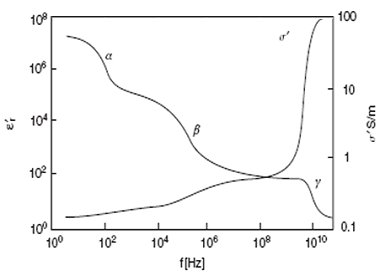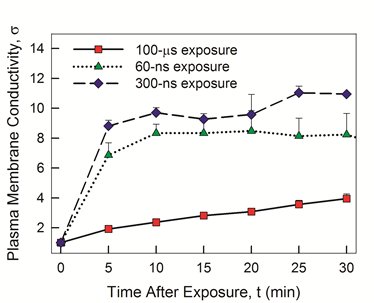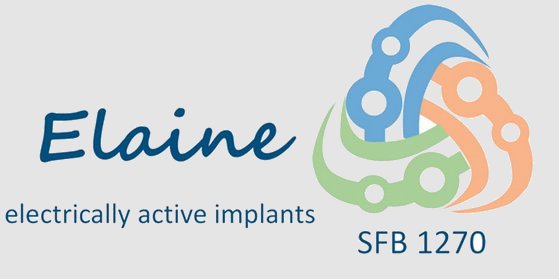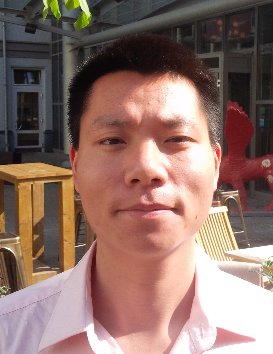Electrical Properties of Cells, Tissues and Materials
Dielectric spectroscopy (also known as electrical impedance spectroscopy) is a non-invasive method to determine basic electrical parameters of materials and
components of materials. Accordingly the method is frequently used in material sciences, however, can also be applied towards living tissues or cells in suspensions.
Conversely, information on conductivity and permittivity, collected over a wide frequency range, yields information on the investigated tissue itself, such as for
example cell membrane composition and structure. H.P. Schwan was the first to describe distinct dispersion relations in dielectric spectra of biological cells that
can be exploited accordingly (H.P. Schwan, "Electrical Properties of Tissue and Cell Suspension," Advances in Biological and Medical Physics 5, 1957, 147).
Originally we intended to use dielectric spectroscopy as an additional method for the investigation of the effects of pulsed electric fields on cells. However,
in the meantime the method became increasingly important in our research by itself. dielectric spectroscopy can be used to determine changes of the cell shape and
even functional changes in the status of cells. With the appropriate model (e.g. single shell or double shell model) it is also possible to obtain information on
subcellular structures, such as the nucleus.
The main part of our work aimed to understand the effects of pulsed electric fields which are able to initiate apoptosis in cancer cells. For this purpose, methods and models had to be developed for measurements on cells in electrolytes with a higher conductivity. Measurements of samples under physiological conditions can lead to strong polarization effects at the interface between the electrode and the suspending medium due to charge accumulation. The impact from electrode polarization could be overcome by plating a layer of platinum black to the measuring electrodes To address challenges of data acquisition and analysis of dielectric spectra, different approaches are combined. Further developed models were applied to the measured dielectric parameters enabling statements about cells and their constituents, such as the cytosol or the cell membrane itself. Furthermore, information about the characteristics of the interface layer at the electrode or its coating can be derived. We have, hence, in the meantime applied dielectric spectroscopy not only to evaluate the effects of pulsed electric fields on cells but also to investigate changes to polymers that have been subjected to submerged plasmas. More recently we have further developed methods and procedures to monitor attachment and growth of cells on metal surfaces. In related studies we describe the cohesion between cells in a monolayer.
|
 |
Projects
Dielectric evaluation of cellular and interfacial characteristics for electrical stimulation: CRC 1270 ELAINE - A05 (2nd phase)
→ click to expand/collapse to show/hide details Project funding: German Science Foundation (DFG) as individual project within the Collaborative Research Centre 1270 'Elaine'", July 2021 - June 2025 (2nd funding phase).
Research and development on the dielectric characterization of osseos tissues and their development under electrical stimulation continue in the second funding phase of the
CRC 1270 ELAINE . Especially analytical methods and models were developed
during the first phase, which will now be applied towards pertinent questions for the development of bone cells and their maturation into a healthy bone with the goal to further
establish electrical impedance spectroscopy as a viable alternative diagnostic method. Within the project
A05 - Dielectric evaluation of cellular and interfacial characteristics for electricl stimulation the differentiation and especially calcification of bone cells will be investigated
by respective methods to determine their status and how their maturation can be fostered by electrical stimuli.The experience from the in vitro experiments will be transfered towards
related studies on the actual remodelling of bones.Concurrently, novel approaches will be explored to devise clinical relevant techniques, which exploit the non-invasive advantage of the approach.
The goal is to eventually develop dielectric measurements towards a non-invasive method that allows monitoring of the integration of implants with respect to patient-specific differences.
Impedance analysis of the calcification of bone cells
→ click to expand/collapse to show/hide details Master Thesis Research Project, Fabian Klemmstein, June 2020 - January 2021.
The aim of the project is to monitor the differentiation of bone cells and in particular their calcification by an analysis of changes of their impedance. Therefore, MG-63 osteosarcoma cells
were seeded on an electrode array and observed for at least 21 days. Changes for the impedance of cell monolayers, with the expression of calcium initiation by a ddifferentiation medium, were especially
observed for the real part of the impedance. The increase of this resistance was more pronounced for the cultivation in only a proliferation medium until the an actual differentiation could be observed
after about 7 days. Subsequently, distinct difference between both media were observed that could be related to changes in the calcium mass in the cell culture. The results provided
an important first insight in the process and the possibility for monitoring by impedance measurments. With the electrode array it will in the future also be possible to apply an electrical stimulus.
With a more detailed analysis by equivalent circuit models, we anticipate that we will also be able to distinguish and describe adhesion characteristics. Both objectives are an important
goal within the ongoing work for a better understanding of an electrical stimulation of bone cells and their growth on respective implants, as it is aim of the CRC 1270 ELAINE.
Characterization of trabecular bone based on the assessment of impedance spectra
→ click to expand/collapse to show/hide details Doctoral Research Project, Wenzuo Wei, August 2018 - July 2022.
The aims of the project are aligned with the objectives of the CRC 1270 ELAINE to improve our understanding
of electrically active implants. Wenzuo is as a doctoral student in the project
A05 - Dielectric characterization of cells, tissues and materials studying different ways for the derivation of bone tissue properties from an analysis of impedance data in a frequency range from DC to
several MHz. Commonly, Cole models and equivalent circuits are applied towards such an evaluation. However, Wenzuo found that their sensitivity and also predictive potential for clinical applications is limited.
Accordingly, he engaged in more advanced methods of assessment, such as the Linear Discriminant Analysis (LDA). With this statistical approach he was able to unambigiously distinguish very similar regions of
trabecular bone from each other. The advantage of the approach for the classification of pathological conditions is obvious. Together with a Cole model he was further able to determine bone volume fractions,
which is arguable the most important parameter to assess bone stability. By the combination with Effective Medium Approximations it is possible to determine the contributions of not just bone strucutures
but also constituents, e.g. water and fat, to the overall electrical properties. Consequently, bulk but patient-specific permittivities and conductivities can be related to composition and structure of the bone. These parameters
are important information for modelling efforts to describe the distribution of electric fields and currents that can be provided by electrical stimuli. Conversely, impedance measurements can be applied to
monitor the success of such therapies.
Dielectric characterization of cells, tissues and materials: CRC 1270 ELAINE - A05
→ click to expand/collapse to show/hide details Project funding: German Science Foundation (DFG) as individual project within the Collaborative Research Centre 1270 'Elaine'", July 2017 - June 2021.
The overall goal of the CRC 1270 ELAINE is the detailed understanding of the electrical stimulation of tissues
for the improvement of therapeutic options. The dielectric properties of cells and tissues determine their response to electrical stimulation. Electrical characteristics will be investigated in project
A05 - Dielectric characterization of cells, tissues and materials by dielectric spectroscopy. The initial objectives are the description of trabecular bone, the evaluation of electrode interfaces,
including coatings, and the assessment of bone cell growth on surfaces. The goal is to eventually develop dielectric measurements towards a non-invasive method that allows monitoring of
the integration of implants with respect to patient-specific differences. Future work also aims to apply methods and procedures towards other tissue types, such as cartilage, and the
detailed assessment of stimulation parameters with respect to the development of exposed cells.
Impedimetric analysis of biological cell monolayers before and after exposure to nanosecond pulsed electric fields
→ click to expand/collapse to show/hide details Doctoral Research Project, Fukun Shi, October 2015 - July 2020. Project funding: Chinese Scholar Council
The aim of the project were the investigation of changes that are induced by nanosecond pulsed electric fields (nsPEFs) on cell monolayers by impedimetric analysis. The study of cell monolayers
provides an important step from the understanding of effects on individual cells towards the description of collective mechanisms of cells that are connected and interacting in a tissue.
Since the treatment of tumors is the main motiviation for the application of nsPEFs, the distinction of cancer cells from 'normal' cells and respective differences of any effects was the
driving objective behind the studies.Models and method for the interpreatein of impedance spectra before and after electrical stimulation, focusing on nsPEFs, were investigated to describe salient
features and their development that were observed in dedicated in situ experimental studies. For the first time a non-invasive, real-time and label-free method was established to explore
temporal changes and their underlying physical processes of adherent cells for characteristics of cell-cell connections and the extracellular matrix. Therefore, different procedures for a reduction
and visualization of impedance data for cell monolayers were developed on the basis of complex nonlinear least squares, multivariate analysis or a deconvolution method. These approaches pave the way
for a sensitive distinction and quantification of effects of electrical stimulation on different cell lines. The investigation encourages the further development into a clinical tumor diagnostic,
especially for the treatment with nsPEFs but in general alos other methods of electrical stimulation.
|




